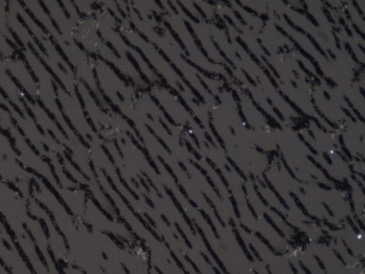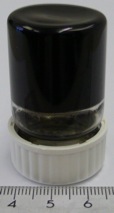Nanoparticle dispersion
In academic research as well as applied work with nanoparticles, the particles are typically handled as colloidal dispersions. Hydrophobic nanoparticles, such as carbon nanotubes or graphene flakes, are typically dispersed in a water-based continuous phase with the help of surfactants (or other amphiphiles) that adsorb at the particle-solvent interface and stabilize the system from particle aggregation [1]. Since these systems are almost always thermodynamically unstable such kinetic stabilization is absolutely essential for being able to work with these particles in an efficient way.

A carbon nanotube dispersion that allows macroscopic organization of the tubes by shearing.
Although the surfactant-based stabilization is a well established approach to achieve nanoparticle colloids there are actually many issues that have not been well investigated. In collaboration with Dr. Giusy Scalia, we have been working for several years in improving carbon nanotube dispersion quality, with particular interest in the case of dispersion in liquid crystalline hosts. For non-liquid crystalline suspensions, we also presented a useful approach to ensure that just the right amount of surfactant is used for dispersion of hydrophobic nanoparticles, taking advantage of dispersion below the so-called Krafft temperature, where the surfactant cannot form micelles.
Currently, our main activity dealing with nanoparticles focuses on spherical gold nanoparticles added to thermotropic liquid crystals. This is the theme of the post-doc project DISGONA of Dr. Martin Urbanski.

A dispersion with well exfoliated carbon nanotubes forms a physical gel at the relatively low nanotube concentration of 3 wt.-%.
Some of our key publications on the topic are the following:
- Utilizing the Krafft phenomenon for achieving ideal micelle-free surfactant-stabilized nanoparticle suspensions
Sarah Dölle, Bob-Dan Lechner, Ji Hyun Park, Stefan Schymura, Jan P. F. Lagerwall and Giusy Scalia
Angewandte Chemie - Int. Ed., 51, pp. 3254-3257 (2012) - Carbon nanotubes in liquid crystals (Review article)
Jan P. F. Lagerwall, Giusy Scalia
J. Mater. Chem. 18, 25, pp. 2890-2898 (2008), special issue on ‘Liquid crystals beyond display applications’. - Filament formation in carbon nanotube-doped lyotropic liquid crystals
Stefan Schymura, Sarah Dölle, Jun Yamamoto and Jan Lagerwall
Soft Matter, 7, 6, 2663 - 2667 (2011) - Tailor-designed polyphilic promotors for stabilizing dispersions of carbon nanotubes in liquid crystals
Martin Kühnast, Carsten Tschierske and Jan Lagerwall
Chem. Commun., 46, pp. 6989-6991 (2010) - Towards Efficient Dispersion of Carbon Nanotubes in Thermotropic Liquid Crystals
Stefan Schymura, Martin Kühnast, Vanessa Lutz, Stefan Jagiella, Ursula Dettlaff-Weglikowska, Siegmar Roth, Frank Giesselmann, Carsten Tschierske, Giusy Scalia, and Jan Lagerwall
Adv. Funct. Mater., 20, 19, pp. 3350–3357 (2010) - Macroscopic-scale carbon nanotube alignment via self-assembly in lyotropic liquid crystals
S. Schymura, E. Enz, S. Roth, G. Scalia, J.P.F. Lagerwall
Synth. Met., 159, 21-22, pp. 2177-2179 (2009) - Spontaneous macroscopic carbon nanotube alignment via colloidal suspension in
hexagonal columnar lyotropic liquid crystals
G. Scalia, C. von Bühler, C. Hägele, S. Roth, F. Giesselmann, and J.P.F. Lagerwall
Soft Matter, 4, 3, pp. 570-576 (2008) - Nanotube alignment using lyotropic liquid crystals
Jan P. F. Lagerwall, Giusy Scalia, Miroslav Haluska, Ursula Dettlaff-Weglikowska, Siegmar Roth, Frank Giesselmann
Adv. Mater. 19, 3, pp. 359-364 (2007)
References
[1] H. Wang, ‘Dispersing carbon nanotubes using surfactants’, Curr. Opin. Colloid Interface Sci., 14, pp. 364-371 (2009)
 Back to research overview.
Back to research overview.
ERROR Global content file could not be located. Do you have your link setting set properly? (GC File:../../(null)/(null))






